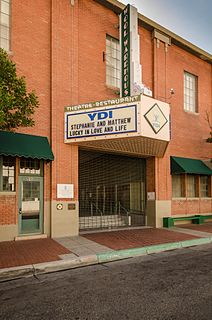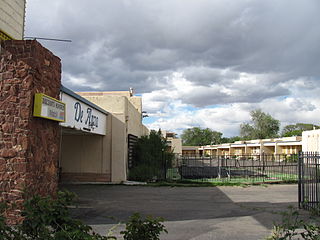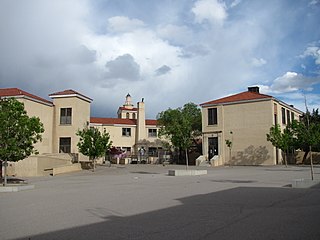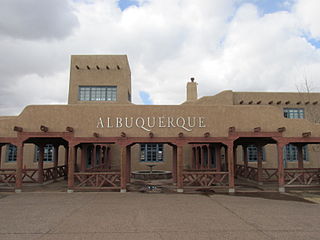
Jones Motor Company is a historic U.S. Route 66-era building in Albuquerque, New Mexico. Built in 1939, on Central Avenue in the Nob Hill neighborhood of Albuquerque, the building originally housed Ralph Jones' service station and Ford Motor Company car dealership. It was designed by Tom Danahy in the Streamline Moderne style, with curved garage bays surmounted by a central stepped tower.

Old Town is the historic original town site of Albuquerque, New Mexico, for the provincial kingdom of Santa Fe de Nuevo México, established in 1706 by New Mexico governor Francisco Cuervo y Valdés. It is listed on the New Mexico State Register of Cultural Properties as the Old Albuquerque Historic District, and is protected by a special historic zoning designation by the city. The present-day district contains about ten blocks of historic adobe buildings surrounding Old Town Plaza. On the plaza's north side stands San Felipe de Neri Church, a Spanish colonial church constructed in 1793.

The historic U.S. Route 66 ran east–west across the central part of the state of New Mexico, along the path now taken by Interstate 40 (I-40). However, until 1937, it took a longer route via Los Lunas, Albuquerque, and Santa Fe, now roughly New Mexico State Road 6 (NM 6), I-25, and US 84. Large portions of the old road parallel to I-40 have been designated NM 117, NM 118, NM 122, NM 124, NM 333, three separate loops of I-40 Business, and state-maintained frontage roads.
Central Avenue is a major east-west street in Albuquerque, New Mexico, which historically served as the city's main thoroughfare and principal axis of development. It runs through many of Albuquerque's oldest neighborhoods, including Downtown, Old Town, Nob Hill, and the University of New Mexico area. Central Avenue was part of U.S. Route 66 from 1937 until the highway's decommissioning in 1985 and also forms one axis of Albuquerque's house numbering system. It was also signed as Business Loop 40 until the early 1990s when ownership of Central Avenue was transferred from the New Mexico State Highway Department to the City of Albuquerque.

The Hook and Ladder House No. 5 and the Detroit Fire Department Repair Shop are two cojoined structures located at 3400 and 3434 Russell Street in Detroit, Michigan. The Hook and Ladder House No. 5 is the second oldest surviving fire station in Detroit, was designated a Michigan State Historic Site in 1975 and was listed on the National Register of Historic Places in 1997.

The Aztec Motel, also known as the Aztec Auto Court or Aztec Lodge, was a historic motel located on former U.S. Route 66 in the Upper Nob Hill neighborhood of Albuquerque, New Mexico, United States. Until its demolition in 2011 it was the oldest continuously-operating Route 66 motel in New Mexico and "one of the five most important motels left" in Albuquerque.

The Central Fire Station is located in downtown Davenport, Iowa, United States and serves as the headquarters of the Davenport Fire Department, as well as the downtown fire station. Built from 1901 to 1902, the original building is the oldest active fire station west of the Mississippi River. It was individually listed on the National Register of Historic Places in 1982. In 2020 it was included as a contributing property in the Davenport Downtown Commercial Historic District.

Castle Apartments was a historic apartment building in Albuquerque, New Mexico, United States, which was destroyed by fire in 2009. It was located on the southeast corner of 15th Street and Central Avenue, roughly halfway between Downtown and Old Town, and took its name from the Huning Castle mansion, which originally stood on the other side of 15th Street.

The Southern Union Gas Company Building is a historic building in downtown Albuquerque, New Mexico, which is notable as one of the earliest International style buildings in the city. Built in 1951, it was the largest of several Southern Union offices around the state designed by southwestern architect John Gaw Meem. Meem was much better known for working in the Pueblo Revival style but did design a handful of other modernist buildings, such as the Colorado Springs Fine Arts Center.

The Wool Warehouse is a historic building in the Warehouse District of downtown Albuquerque, New Mexico. Built in 1928–29 by wool merchant Frank Bond, the warehouse is significant for its role in New Mexico's wool industry in the mid-20th century. It was added to the New Mexico State Register of Cultural Properties in 1980 and the National Register of Historic Places in 1981.

The De Anza Motor Lodge was a historic motel located on former U.S. Route 66 in the Upper Nob Hill neighborhood of Albuquerque, New Mexico. It was built in 1939 by Charles G. Wallace, a local trader of Zuni art and pottery, who remained the owner until 1983. Wallace decorated the motel with a variety of Native American art, including a series of murals by Zuni artist Tony Edaakie in a basement room.
Tjalke Charles Gaastra was an American architect who worked in the American southwest in the first half of the twentieth century. He won the International Exhibit of Architecture in Berlin for the Gildersleeve house in Santa Fe, New Mexico which he designed for New Mexico Supreme Court justice, David Chavez. Gaastra was a major player in the Spanish Pueblo Revival architectural style in Santa Fe, New Mexico.

Nob Hill Business Center is a historic shopping center in Albuquerque, New Mexico. Built in 1946–7, it was the first modern suburban shopping center in New Mexico, and its construction marked a shift away from pedestrian-oriented development in Albuquerque in favor of decentralized, auto-oriented sprawl. Located on Central Avenue at Carlisle Boulevard, the building is the focal point of the Nob Hill district.

Nob Hill is a neighborhood in Albuquerque, New Mexico, consisting of a commercial district along Central Avenue and surrounding residential areas. Located just east of the University of New Mexico, the neighborhood was developed between about 1925 and 1950 and has since become a popular tourist and shopping destination. Known for its eclectic mix of mostly locally owned businesses, Nob Hill has been described as "the heart of Albuquerque's Route 66 culture and also its hippest, funkiest retail and entertainment district". The neighborhood is named after Nob Hill in San Francisco.

The Hendren Building is a historic commercial building in the Nob Hill neighborhood of Albuquerque, New Mexico. Built in 1946, it is one of the city's most notable examples of Streamline Moderne architecture, and representative of the boom in automobile-oriented commercial development in the immediate post-war period. The building was one of the last completed works by architect T. Charles Gaastra. It was added to the New Mexico State Register of Cultural Properties in 1999 and the National Register of Historic Places in 2000.

Monte Vista Elementary School is a public elementary school in the Nob Hill neighborhood of Albuquerque, New Mexico, whose campus is listed in the New Mexico State Register of Cultural Properties and the National Register of Historic Places. It is notable as one of the city's best examples of Mediterranean Revival architecture and as the historical focal point of the surrounding neighborhood.

Cedar Rapids Central Fire Station, also known as Cedar Rapids Hose Company No. 1 and the Cedar Rapids Science Station, is a historic building located in Cedar Rapids, Iowa, United States. It served as the city's fire department headquarters and downtown fire station from 1918 to 1985. It replaced a frame structure in the northeast quadrant, and was part of a larger program of building new facilities for the local fire department. The building program was a response to a series of disastrous fires, changing technology, and the city's growth. This fire station served from the era of horse-drawn pumper wagons to the modern era of fire engines, pumpers, and hook and ladder trucks. The two-story, brick Mission and Spanish Colonial Revival structure was designed by local architect Charles A. Dieman. In the mid-20th century a two-story kitchen addition was built onto the back of the building.

Scholes Hall is the historic administration building of the University of New Mexico, located on the main campus in Albuquerque. It was the first of many buildings designed for the university by Santa Fe architect John Gaw Meem, who helped to cement the Pueblo Revival style as the "official" architecture of the campus. Built in 1934–36 with Public Works Administration funding, it is regarded as one of Meem's most notable designs.

The OldAlbuquerque Municipal Airport Building at 2920 Yale Blvd. SE. in Albuquerque, New Mexico, is a Pueblo Revival building built in 1939. It was listed on the National Register of Historic Places in 1989.



















